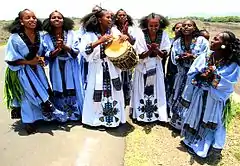Ashenda
Ashenda is an annual Eritrean & Tigrayan festival which celebrates women and girls.[1] It's believed to have originated in Axum region of Tigray, scholars estimate it began around 400 AD. The festival takes place in August and mainly celebrated in Tigray and has been adopted in bordering regions of Ethiopia and Eritrea.[2] Tigrayan & Eritrean women living throughout the world try to make it to Mekelle or in their respective village within Eritrea where the Ashenda festival takes place. Only women participate in the celebration while the men mostly play the role of gifter in some cases protectors from potential harassment as the younger girls travel door to door singing Ashenda songs and receiving gift like money, traditional food made for the festival. The festival comes after the two weeks of Filseta. During Filseta, people fast, or do not eat, through the day. Filseta and Ashenda honor the Virgin Mary.
| Ashenda | |
|---|---|
 | |
| Official name | Ashenda |
| Also called | Girls' Day |
| Observed by | Primarily Tigray, Sekota, Amhara, Eritrea and SNPPR... |
| Type | Cultural |
| Begins | 16 August |
| Ends | 26 August |
| Date | After the end of Filseta |
| Frequency | Annual |
| Related to | Filseta |
In the festival, young women and girls wear white cotton dresses. These dresses have colorful embroidery, called tilfi. They also wear a lot of jewelry. They weave ashenda grass into a bunch, and wear it where on their backs, or as a skirt.[3] Ashenda, in the Tigrinya language, is a tall green grass that grows on river banks.[4] Girls often wear five cornrow braids in their hair. They wear Kohl eyeliner.[5]
On the first day, the girls gather at the middle of the town or village. Then they break up into groups, and walk through the town. They sing and dance for the people in every house, and also in the village square. The people in each house give them money, food, drinks, or other gifts. The women and girls give these gifts to poor people. They sing and dance all day until sunset. This festival may last for a week or more.
Ashenda is thousands of years old. It existed even before Ethiopia became Christian, in the 4th century AD.[4] as the Tigrayans migrated down south they brought the culture to the southern part of Ethiopia it was adopted reflecting the spirit and culture of the locals developing new name E.g. in Wello region it's called Shadey, Agew Awi Zone they call is Ashendye, in Gojjam and Shewa region they call it Solel, or Mariya.
The stigma of Ashenda: The act of singing going door to door was not always receivd well by all Ethiopians & Eritreans who likened it to act of begging as clashes of culture, it often became a racist and xenophobic attack against Tigrayans labeling them as "Lemange" or "beggers" but since 1991 through EPDRF government education program that focused in cultural tolerance and as Ethiopians & Eritreans became exposed to different cultures around due to the digital revolution there have been a shift in attitude. Even though the stereotypes and racist terms still persist. often used to dehumanize Tigrayans during the Tigray Genocide.[6] Some Ethiopians are trying to get Ashenda listed by UNESCO as an intangible cultural heritage.[7]
Celebration
Leading up to Ashenda, women and girls will prepare to adorn themselves with jewelry, dresses, henna, and diverse cultural hairstyles. On the first day of the festival, Ethiopian girls gather together and make the journey to their local Church of St. Mary (or any other Orthodox Tewahedo Church in the community), playing music and dancing. They then go around the entire village, expressing their thanks to each household in the community. The Ashenda girls spend around 20 minutes at each house, entertaining families and themselves, before being bid farewell usually with gifts of money, food or drink. After the door-to-door celebrations, the girls find a suitable field in or near the village, spending between a day to a week dancing and playing in the field while passing men are urged to provide gifts of money.
All money and gifts collected over the course of the celebration are then donated to a charity, the Church or other events.
Name
Ashenda is named after the long, thin "Ashenda" grass which girls tie to hang down from their waists in a fashionable pattern. The Ashenda grass has come to symbolize the religious festival, as dancing girls move their waists causing the leaves to shake in an eye-catching manner. The festival is also called "Shadey", "Maria", "Aynewari", "Ashendye", "Solel", and "Engicha".[8]
See also
References
- "Ashenda Women's Festival". Ethiopian Quadrants. Retrieved 18 September 2023.
- "Ashenda - Girls Feast". Hadgi Tourism. Retrieved 18 September 2023.
- Teffera, Timkehet (2019). "Ethiopian & Eritrean Magnificent Holidays: A Case Study of the Ašända Feast. Chapter II Part I".
- "ASHENDA: Ethiopia's Multihued Intangible Heritage". ENA. 26 August 2019.
- "Ethiopians from war-ravaged Tigray celebrate holiday in Sudan". Al Arabiya English. 7 September 2022.
- Hern, Alex (14 December 2022). "Meta faces $1.6bn lawsuit over Facebook posts inciting violence in Tigray war". The Guardian. Retrieved 18 September 2023.
- Hailou, Sesina (31 August 2019). "A holiday just for women". The Reporter (Ethiopia).
- "Ashenda, Ashendye, Aynewari, Maria, Shadey, Solel, Ethiopian girls' festival - intangible heritage". Culture Sector, UNESCO. Retrieved 21 August 2022.
Further reading
- Yohannes, Gebregeorgis (2010). Tirhas Celebrates Ashenda: An Ethiopian Girls' Festival. Sololia Publishing. ISBN 9781883701024.